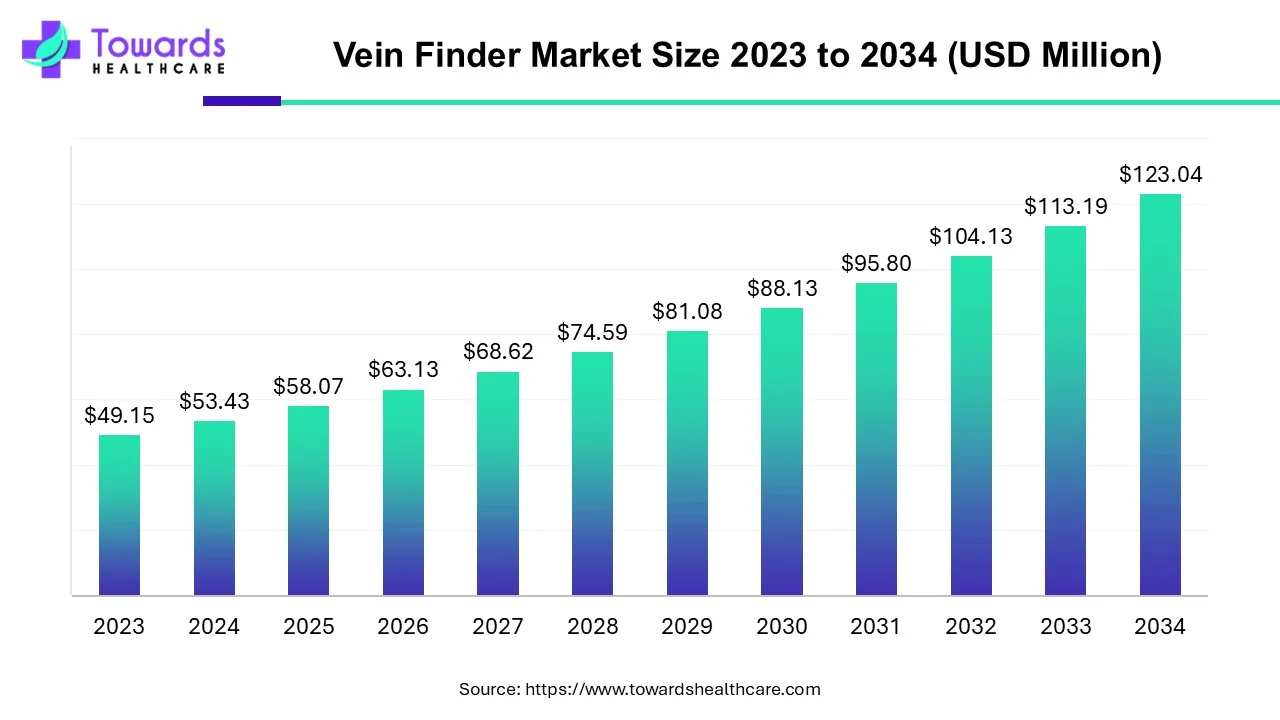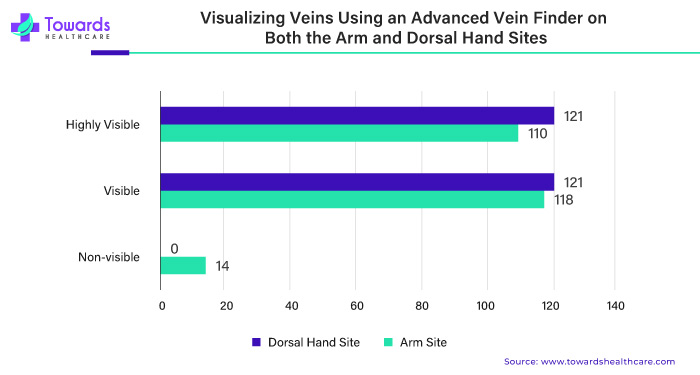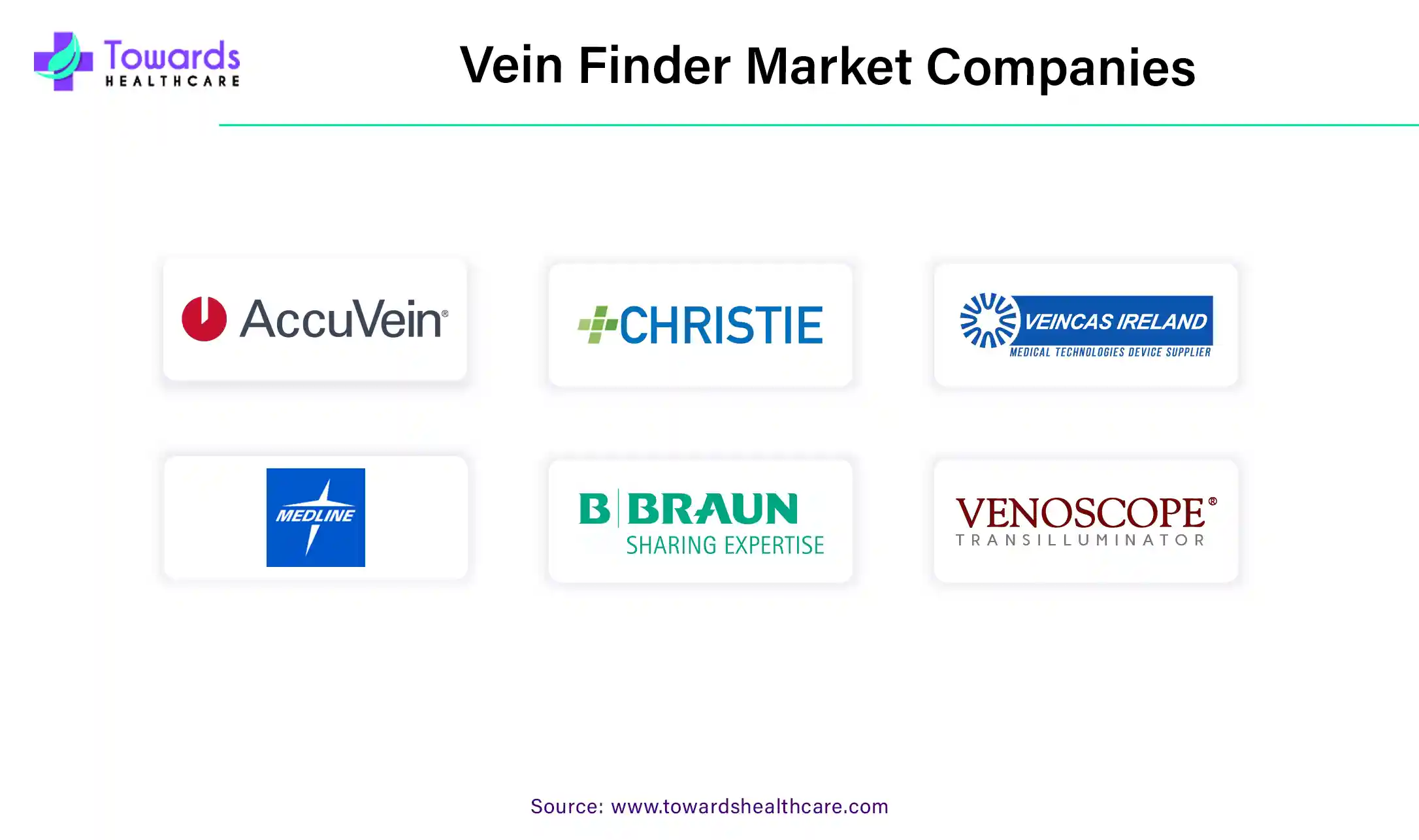November 2025

The vein finder market size is projected to reach USD 123.04 million by 2034, growing from USD 58.07 million in 2025, at a CAGR of 8.7% during the forecast period from 2025 to 2034. The growing demand for intravenous drug delivery and technological advancements boost the market.

According to the World Health Organization, by 2050, the number of people aged 60 and older will double, reaching 2.1 billion, while those aged 80 or older will triple to 426 million. With the aging population, more people will face health challenges, making vein finding harder. This increased demand calls for advancements in vein finder technology.
The vein finder market deals with devices designed to help healthcare professionals locate veins in patients' bodies. These devices use various technologies like near-infrared light to illuminate veins, making them easier to see, especially in patients with difficult-to-locate veins, such as children, elderly individuals, or those with darker skin tones.
The importance of vein finders lies in their ability to assist medical staff in tasks like venipuncture (drawing blood), inserting IV lines, or administering medications. By accurately identifying veins, these devices can reduce patient discomfort, minimize the risk of complications like bruising or multiple needle sticks, and improve overall efficiency in medical procedures.
For instance,
Vein finders have a range of applications across different medical settings, including hospitals, clinics, emergency rooms, and even in-home healthcare. They are precious when vein visibility is poor or healthcare providers must work quickly and accurately.
For instance,

The market for vein finders is expected to grow steadily due to several factors. The rising demand for minimally invasive procedures and the increasing number of medical procedures requiring venous access contribute to the market's growth. Additionally, technological advancements lead to more portable and user-friendly. The aging population worldwide, which often presents challenges in vein access, also fuels the demand for vein finder devices.
The vein finder market is poised for growth as healthcare providers continue to recognize the importance of accurate vein visualization for improving patient care outcomes and enhancing procedural efficiency.
Artificial intelligence (AI) enables the detection of veins faster and more accurately. Integrating AI in vein finder devices can enhance efficiency and introduce automation. It can generate real-time images of a patient’s veins and send them to healthcare professionals, enabling them to provide advanced care from a remote location. It can suggest providers with the best insertion points for cannulation. This enhances the success rate of venipuncture and reduces patient discomfort. Advancements in wireless connectivity technology can seamlessly transmit data to electronic medical records, enabling record-keeping and retrieval of patient data. AI-enabled augmented reality (AR) and virtual reality (VR) can offer real-time virtual assistance, improving accuracy.
Vein finders help medical professionals locate suitable veins for blood draws, intravenous (IV) catheter insertion, and infusion therapy. This is particularly helpful in patients with difficult venous access, such as those with small or fragile veins, or individuals who are obese or have dark skin.
Vein finders assist in placing intravenous lines for administering medications, fluids, or contrast agents needed for diagnostic imaging procedures like CT scans or MRI scans.
Vein finders aid in collecting blood samples for laboratory testing and diagnostic purposes. They help ensure accurate sample collection while minimizing discomfort and the risk of complications such as hematoma or infiltration.
Vein finder devices can assist in assessing peripheral vascular conditions by visualizing superficial veins. While they do not directly diagnose vascular diseases, they can aid in the identification of venous insufficiency, varicose veins, or thrombosis by highlighting abnormal vein patterns or flow characteristics.
Vein finders are particularly valuable in pediatric settings, where locating veins in children can be challenging due to their smaller size and limited cooperation. These devices help reduce the stress and discomfort associated with enipuncture procedures in pediatric patients.
By 2030, about one out of every six individuals globally will be aged 60 years or older. This time, the portion of the population in this age group is anticipated to rise from 1 billion in 2020 to 1.4 billion. Looking ahead to 2050. The global population of individuals aged 60 years and older is set to double, reaching 2.1 billion. The number of individuals aged 80 years or older is predicted to triple between 2020 and 2050, reaching 426 million. With the aging population worldwide, more individuals will encounter health issues that can make finding veins challenging. Vein finder devices play a crucial role in assisting medical professionals, such as doctors and nurses, in locating veins more easily. This is particularly vital for blood collection or administering medication through an intravenous line.
Older adults often have thinner or harder-to-see veins due to aging, making vein finders even more critical for their care. With the elderly population growing, the need for vein finders increases because more older people will require medical procedures. These devices make procedures safer and less painful for older patients, reducing the risk of complications like bruising or missed veins. Older adults tend to have more health issues requiring medical care, so the demand for vein finders rises to ensure accurate and efficient treatment.
Additionally, older individuals often have conditions like diabetes or high blood pressure, which can affect vein health, making vein finders essential for proper medical care. The aging population also means more people needing regular medical check-ups and treatments, further driving the need for vein finders in healthcare settings. The increasing number of elderly individuals worldwide creates a greater demand for vein finders to ensure effective and comfortable medical procedures for this demographic.
Visualize your veins as tiny rivers flowing beneath your skin. However, in individuals who are obese or have specific medical conditions, identifying these rivers can be challenging. It's akin to searching for a concealed path within a dense forest.
This is where vein finders step in as lifesavers! Comparable to special goggles worn by doctors and nurses, these devices utilize innovative technology, such as infrared light, to penetrate the skin and locate these elusive veins. It's as if they're illuminating a spotlight on the hidden river, simplifying navigation for medical professionals. These vein finders come in handy when someone needs a blood test or an IV. They help medical teams find veins quickly and accurately, reducing the stress and discomfort for patients. It's like having a treasure map to guide them through the forest of your veins, ensuring a smoother and more successful procedure. And that's why vein finders are such valuable tools in healthcare.
Technological advances, like infrared imaging and near-infrared (NIR) technology, have jazzed up vein finders. Imagine them as superhero goggles for doctors and nurses—they help see through your skin to find those pesky veins without poking around too much.
Infrared imaging, for example, works like magic glasses that can see beneath your skin. It detects the heat from your body, highlighting your veins in a way that's easy for medical pros to spot. It's like having a special flashlight that shows your veins as clear as day, even if they're hiding deep beneath your skin.
Near-infrared technology takes it a step further. It uses light waves that can penetrate your skin but aren't visible to the naked eye. These waves bounce back differently depending on what they hit. Veins reflect this light differently from the surrounding tissue, creating a clear map for healthcare workers.
These technologies have made vein finders more accurate and easier to use. They've become trusty sidekicks for medical teams, helping them find veins quickly and with less hassle. These tools allow doctors and nurses to perform procedures more smoothly, causing less patient discomfort. No wonder these high-tech vein finders are becoming a staple in hospitals and clinics everywhere!
There needs to be more awareness and training about vein finder technology in healthcare. Think of it like having a super tool but needing to learn how to use it properly. Some doctors and nurses might need to learn about these gadgets exist or how helpful they can be in finding veins.
Without proper training, using vein finders might feel like trying to solve a puzzle without knowing all the pieces. It can lead to mistakes or not using the device to its full potential, making procedures harder for patients and less effective.
Imagine driving a car without learning how first – it could be dangerous! Similarly, healthcare pros must know how to use vein finders correctly to ensure they're helping patients best.
To overcome this, healthcare facilities must invest in training programs and ensure all staff know about vein finder technology. With the proper education, medical teams can use these tools confidently, making procedures smoother and less stressful for everyone involved.
By product type, the portable segment held a dominant presence in the market in 2024. The growing demand for portable devices due to the rising geriatric population boosts the segment’s growth. Portable devices enable patients and healthcare professionals to locate veins accurately from a remote place, thereby eliminating the need to visit any healthcare setting. Portable devices can allow patients to inject medications with ease. These devices reduce healthcare costs and improve patient compliance.
By product type, the benchtop segment is expected to grow at the fastest rate in the market during the forecast period. Benchtop vein finders are installed in hospitals or other healthcare organizations. It is an advanced medical device that assists healthcare professionals in locating veins for venipuncture procedures. The increasing number of hospitalizations due to severe acute and chronic disorders potentiate the segment’s growth. These devices can be used in multiple patients for locating veins, making them affordable for many patients from low- and middle-income countries.
By technology, the infrared segment held the largest share of the market in 2024. Infrared and near-infrared technologies are the most common to locate veins, enabling healthcare professionals to visualize superficial vasculature. Infrared vein finders can improve accuracy and speed in vein location. Clinicians can see veins, valves, and bifurcations that are not visible to the naked eye, leading to better-informed site assessment decisions. They are safer for patients of all ages and are comparatively cost-effective.
By technology, the ultrasound segment is anticipated to grow with the highest CAGR in the market during the studied years. Ultrasound vein finders use sound waves to create real-time images of veins and surrounding tissues. They result in clear images of veins at depths from 1 to 5 centimeters. Ultrasound vein finders can also be used in pediatric, adult, and geriatric patients through optimized gain and depth presets.
By end-user, the hospitals segment led the global market in 2024. The increasing number of hospitalizations and suitable capital investments favor the adoption of advanced vein finders. The presence of skilled professionals also fosters the segment’s growth. Thus, patients prefer going to hospitals for the intravenous administration of drugs, requiring the use of vein finders. The increasing number of surgeries and favorable reimbursement policies propel the segment’s growth.
By end-user, the diagnostic & pathology laboratories segment is projected to expand rapidly in the market in the coming years. Diagnostic & pathology laboratories possess specialized equipment and skilled professionals. The increasing number of laboratory tests for routine check-ups require vein finders. Around 14 billion clinical laboratory tests are performed annually in the U.S. Laboratory professionals inject dyes or certain chemicals before MRI or CT scans, thereby necessitating the use of vein finders.
In North America, there are many companies and places where they study and make medical gadgets, including vein finders. This means there's always new and better technology being worked on. These companies compete to make even better vein finders, like ones with excellent imaging or easy-to-use designs. This competition pushes them to keep improving, which is fantastic news for people who need vein finders for medical procedures. In North America, especially in places like the United States and Canada, there are a lot of older folks. As people get older, they tend to have more health issues like chronic diseases or cancer. When doctors need to draw blood or give medicine through a vein, it can be more complex with older patients because their veins are sometimes more challenging to see. That's where vein finder devices come in. They help doctors find veins more efficiently, essential when treating older patients. Since more older people in North America need medical care, there's a more significant demand for these vein finder gadgets in hospitals and clinics all over the region.
The Asia Pacific region experiences a high volume of surgical procedures in hospitals and outpatient settings, fueling the need for vein finder devices to ensure accurate and efficient venous access. The AccuVein AV400 got the green light from the China Food and Drug Administration (CFDA) to be sold in China. This means more products are getting approved for sale in the country, and hospitals and blood donation camps will likely use them more. This should help the overall market in the region to grow. The growing awareness among healthcare professionals about the benefits of vein finder technology in reducing patient discomfort, minimizing procedure time, and improving success rates also contributes to market growth. The increasing adoption of telemedicine and home healthcare services in Asia Pacific countries creates opportunities for portable and user-friendly vein finder devices that can be used outside traditional clinical settings. This trend is particularly significant in remote or underserved areas with limited access to healthcare facilities.
In China, increasing manufacturing of the Vein finder device is increasing, it used to find veins and blood vessels of the patient. China’s Alltrustedmed, a specialised vein viewer manufacturer, offers various types of vein finders. It is applicable in child and infant patients, patients with obese, patients with edema, multiple chemotherapy patients, poor vascular elasticity patients, emergency treatment, shock, patients with a sharp decrease in blood volume, and patients with vascular collapse, which causes the growth of the venous finder market in China.
Eswara Rao Nandam, Founder of Polymatech Electronics, commented on the launch of Vein Detection Light that the launch is a testament to the company’s commitment to innovation in semiconductor technology. The device addresses critical healthcare needs, such as IV infusion failure, providing professionals with a tool that ensures precision and efficiency in vein detection.
Recent advancements in vein finder technology, such as vein visualization devices, make it important for medical care workers to draw blood with infrared light technology of VeinViewer benefit before, during and after venipuncture. The tools make it possible to see through the patient’s skin and detect vessels. VeinViewer is a hand-carried tool that is also appropriate for use in emergency conditions. Vein visualization tool applied in many situations to improve venipuncture or vascular access. It is particularly applicable in vein care centres, for sclerotherapy or for fragile veins in geriatrics and oncology, for limited vein access with dialysis patients, or for triage in the emergency and accident ward. This drives the growth of the market.

By Product Type
By Technology
By End-User
By Region
November 2025
November 2025
November 2025
November 2025